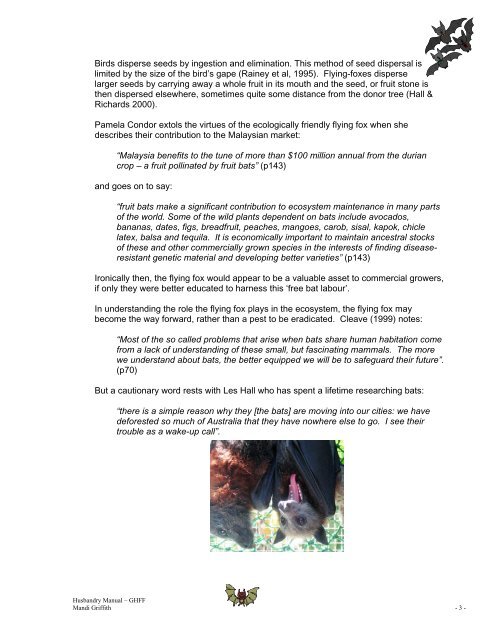Husbandry Manual for Grey- Headed Flying Fox - Nswfmpa.org
Husbandry Manual for Grey- Headed Flying Fox - Nswfmpa.org
Husbandry Manual for Grey- Headed Flying Fox - Nswfmpa.org
You also want an ePaper? Increase the reach of your titles
YUMPU automatically turns print PDFs into web optimized ePapers that Google loves.
Birds disperse seeds by ingestion and elimination. This method of seed dispersal is<br />
limited by the size of the bird’s gape (Rainey et al, 1995). <strong>Flying</strong>-foxes disperse<br />
larger seeds by carrying away a whole fruit in its mouth and the seed, or fruit stone is<br />
then dispersed elsewhere, sometimes quite some distance from the donor tree (Hall &<br />
Richards 2000).<br />
Pamela Condor extols the virtues of the ecologically friendly flying fox when she<br />
describes their contribution to the Malaysian market:<br />
“Malaysia benefits to the tune of more than $100 million annual from the durian<br />
crop – a fruit pollinated by fruit bats” (p143)<br />
and goes on to say:<br />
“fruit bats make a significant contribution to ecosystem maintenance in many parts<br />
of the world. Some of the wild plants dependent on bats include avocados,<br />
bananas, dates, figs, breadfruit, peaches, mangoes, carob, sisal, kapok, chicle<br />
latex, balsa and tequila. It is economically important to maintain ancestral stocks<br />
of these and other commercially grown species in the interests of finding diseaseresistant<br />
genetic material and developing better varieties” (p143)<br />
Ironically then, the flying fox would appear to be a valuable asset to commercial growers,<br />
if only they were better educated to harness this ‘free bat labour’.<br />
In understanding the role the flying fox plays in the ecosystem, the flying fox may<br />
become the way <strong>for</strong>ward, rather than a pest to be eradicated. Cleave (1999) notes:<br />
“Most of the so called problems that arise when bats share human habitation come<br />
from a lack of understanding of these small, but fascinating mammals. The more<br />
we understand about bats, the better equipped we will be to safeguard their future”.<br />
(p70)<br />
But a cautionary word rests with Les Hall who has spent a lifetime researching bats:<br />
“there is a simple reason why they [the bats] are moving into our cities: we have<br />
de<strong>for</strong>ested so much of Australia that they have nowhere else to go. I see their<br />
trouble as a wake-up call”.<br />
<strong>Husbandry</strong> <strong>Manual</strong> – GHFF<br />
Mandi Griffith - 3 -

















